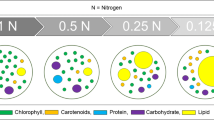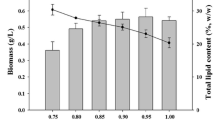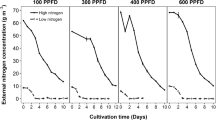Abstract
Identification of nutrient status is essential to Chlorella sp. cultivation for biodiesel production. Critical cellular elemental ratio is a commonly used parameter to assess nutrient status, but the definition of critical cellular elemental ratio is inconsistent, and the influence of light and growth phase on this ratio is still unclear. In this study, Chlorella sp. was batch cultured under different conditions of light and nutrient supply ratio. Nitrate and phosphate consumption in the medium and particulate cellular carbon (C), nitrogen (N), and phosphorus (P) contents were measured. We first obtained the critical nutrient supply ratio to assess nutrient limitation and then utilized this ratio to deduce the critical cellular elemental ratio. The critical nutrient supply ratio was significantly affected by light intensity, and was approximately 45, 15, and between 30 to 45 under light intensities of 50, 100, and 200 μmol photons m−2 s−1, respectively. Critical cellular C/N/P ratios of Chlorella sp. at three light intensities of 50, 100, and 200 μmol photons m−2 s−1 in exponential growth phase were C159.91–237.30N15.90–22.52P, C104.02–167.39N11.71–17.35P, and C144.30–243.66N12.84–19.84P, and in stationary growth phase the ratios were C201.47–406.14N16.55–32.67P, C125.05–298.44N10.12–24.24P, and C168.65–342.42N14.47–29.18P, respectively. These results supported the hypothesis that the critical cellular elemental ratio, which is used to predict nutrient status, varies and depends on light intensity and growth phase.






Similar content being viewed by others
References
Agyei D, Danquah MK (2011) Industrial-scale manufacturing of pharmaceutical-grade bioactive peptides. Biotechnol Adv 29:272–277
Allen MM (1968) Simple conditions for growth of unicellular blue-green algae on plates. J Phycol 4:1–4
Arrigo KR (2005) Marine microorganisms and global nutrient cycles. Nature 437:349–355
Beardall J, Berman T, Heraud P, Omo Kadiri M, Light BR, Patterson G, Roberts S, Sulzberger B, Sahan E, Uehlinger U, Wood B (2001a) A comparison of methods for detection of phosphate limitation in microalgae. Aquat Sci 63:107–121
Beardall J, Young E, Roberts S (2001b) Approaches for determining phytoplankton nutrient limitation. Aquat Sci 63:44–69
CEPA (2002) Monitoring and analysing methods for water and wastewater, 4th edn. China Environmental Science Press, Beijing
Droop MR (1968) Vitamin B12 and marine ecology. 4. Kinetics of uptake growth and inhibition in Monochrysis lutheri. J Mar Biol Assoc UK 48:689–733
Falkowski PG (1997) Evolution of the nitrogen cycle and its influence on the biological sequestration of CO2 in the ocean. Nature 387:272–275
Geider R, La Roche J (2002) Redfield revisited: variability of C:N:P in marine microalgae and its biochemical basis. Eur J Phycol 37:1–17
Geider RJ, Macintyre HL, Kana TM (1996) A dynamic model of photoadaptation in phytoplankton. Limnol Oceanogr 41:1–15
Goldman JC, Mccarthy JJ, Peavey DG (1979) Growth-rate influence on the chemical composition of phytoplankton in oceanic waters. Nature 279:210–215
Griffiths MJ, van Hille RP, Harrison ST (2014) The effect of nitrogen limitation on lipid productivity and cell composition in Chlorella vulgaris. Appl Microbiol Biotechnol 98:2345–2356
Hall SR, Leibold MA, Lytle DA, Smith VH (2007) Grazers, producer stoichiometry, and the light: nutrient hypothesis revisited. Ecology 88:1142–1152
Hecky RE, Campbell P, Hendzel LL (1993) The stoichiometry of carbon, nitrogen, and phosphorus in particulate matter of lakes and oceans. Limnol Oceanogr 38:709–724
Hillebrand H, Sommer U (1999) The nutrient stoichiometry of benthic microalgal growth: Redfield proportions are optimal. Limnol Oceanogr 44:440–446
Klausmeier CA, Litchman E, Levin SA (2004b) Phytoplankton growth and stoichiometry under multiple nutrient limitation. Limnol Oceanogr 49:1463–1470
Klausmeier CA, Litchman E, Daufresne T, Levin SA (2004a) Optimal nitrogen-to-phosphorus stoichiometry of phytoplankton. Nature 429:171–174
Lan S, Wu L, Zhang D, Hu C (2015) Effects of light and temperature on open cultivation of desert cyanobacterium Microcoleus vaginatus. Bioresource Technol 182:144–150
Larkum T, Howe CJ (1997) Molecular aspects of light harvesting processes in algae. Adv Bot Res 27:257–330
Leonardos N, Geider RJ (2004) Effects of nitrate: phosphate supply ratio and irradiance on the C : N: P stoichiometry of Chaetoceros muelleri. Eur J Phycol 39:173–180
Pujopay M, Raimbault P (1994) Improvement of the wet-oxidation procedure for simultaneous determination of particulate organic nitrogen and phosphorus collected on filters. Mar Ecol Prog Ser 105:203–207
Redfield AC (1960) The biological control of chemical factors in the environment. Sci Prog 11:150–170
Rhee GY (1978) Effects of N:P atomic ratios nitrate limitation on algal growth, cell composition, nitrate uptake. Limnol Oceanogr 23:10–25
Rodolfi L, Chini Zittelli G, Bassi N, Padovani G, Biondi N, Bonini G, Tredici MR (2009) Microalgae for oil: strain selection, induction of lipid synthesis and outdoor mass cultivation in a low-cost photobioreactor. Biotechnol Bioeng 102:100–112
Safi C, Zebib B, Merah O, Pontalier P-Y, Vaca-Garcia C (2014) Morphology, composition, production, processing and applications of Chlorella vulgaris. Renew Sust Energy Rev 35:265–278
Singh A, Nigam PS, Murphy JD (2011) Renewable fuels from algae: an answer to debatable land based fuels. Bioresour Technol 102:10–16
Terry KL, Laws EA, Burns DJ (1985) Growth rate variation in the N:P requirement ratio of phytoplankton. J Phycol 21:323–329
Tilman D (1982) Resource competition and community structure. Princeton University Press Princeton, New Jersey
Tyrrell T (1999) The relative influences of nitrogen and phosphorus on oceanic primary production. Nature 400:525–531
Wang B, Li Y, Wu N, Lan CQ (2008) CO2 bio-mitigation using microalgae. Appl Microbiol Biotechnol 79:707–718
White S, Anandraj A, Bux F (2011) PAM fluorometry as a tool to assess microalgal nutrient stress and monitor cellular neutral lipids. Bioresource Technol 102:1675–1682
Wynne D, Rhee G-Y (1986) Effects of light intensity and quality on the relative N and P requirement (the optimum N:P ratio) of marine planktonic algae. J Plankton Res 8(1):91–103
Zheng H, Yin J, Gao Z, Huang H, Ji X, Dou C (2011) Disruption of Chlorella vulgaris cells for the release of biodiesel-producing lipids: a comparison of grinding, ultrasonication, bead milling, enzymatic lysis, and microwaves. Appl Biochem Biotechnol 164:1215–1224
Acknowledgments
This study was financed by the Chongqing Research Program of Basic Research and Frontier Technology (no. cstc2015jcyjBX0006), National Science Foundation of China (no. 41430750 and no. 51309220), and National Key S&T Project on Water Pollution Control and Treatment (no. 2014ZX07104-006). We give personal thanks to Mei Yang and Li Ping Zhang for their help with the laboratory work and to the anonymous reviewers for their comments and advice regarding the manuscript.
Author information
Authors and Affiliations
Corresponding author
Rights and permissions
About this article
Cite this article
Liu, J., Li, Z., Guo, Js. et al. The effect of light on the cellular stoichiometry of Chlorella sp. in different growth phases: implications of nutrient drawdown in batch experiments. J Appl Phycol 29, 123–131 (2017). https://doi.org/10.1007/s10811-016-0962-9
Received:
Revised:
Accepted:
Published:
Issue Date:
DOI: https://doi.org/10.1007/s10811-016-0962-9




